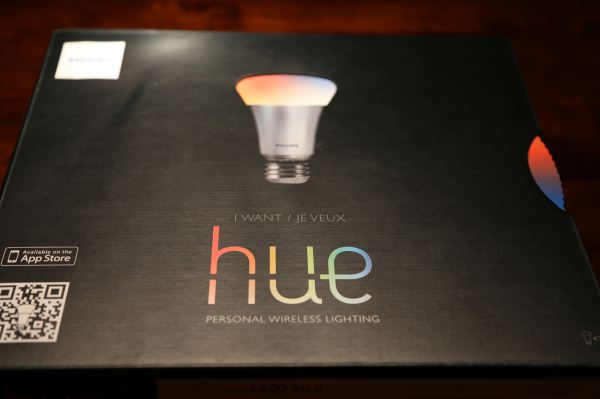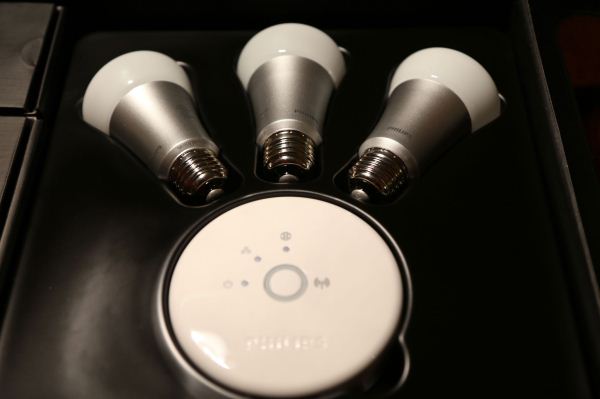Philips Hue: Automated Home Lighting Gets Colorful
by Ashu Joshi on March 1, 2013 12:50 AM EST- Posted in
- Gadgets
- Home Automation
- Philips
- Hue
- Lighting
Introducing the Philips Hue
Before we get started, we’d like to introduce Ashu Joshi to our readers. He has a background in networking and has used a variety of home automation devices over the years. As such, he brings a useful perspective to our staff and can help augment our review coverage. Note also that as with all of our articles, these pieces reflect the opinions of the writer(s) and are not in any way associated with or influenced by any other source (e.g. other employers).
Philips sent out a review sample of their new Hue lighting system, a set of three Hue lights with the Hue Bridge that allows you to remotely control the lights. Besides being able to turn the lights on or off, the big claim to fame of the Hue is that you can set the lights to a variety of colors, or you can even program them to cycle through colors. Home automation systems are often proprietary and can be quite expensive, so the entry of Philips into this market (albeit in a limited fashion) with their Hue lighting system has the potential to shake things up a bit.
The lights have colored LEDs, and while the initial pack only includes three Connected Bulbs (referred to informally as "bulb" or "light" throughout the remainder of this review), you can potentially add up to 50 lights throughout your house/property. One thing that hasn’t changed yet however is that pricing is quite high: the initial Starter Pack will set you back $200. But how does the Philips Hue work in practice, and could it be worth the cost of entry? Note that at present, the Philips Hue is only appears to be sold through the Apple Store as an “App-Enabled Accessory”, but Android is also supported. Long-term we will likely see support for other operating systems as well, but for now this is primarily an iOS/Android targeted device.
Packaging and Contents
One thing that immediately stands out with the Philips Hue is the packaging. It’s very well designed and eye-catching, and I love that you’re able to get a preview of the lighting options with the dial on the box. I set up my Philips Hue controller and bulbs recently, and my initial impressions have been very positive. It’s very easy to install and the experience of this lighting system is quite the change from your everyday lights. I uploaded a few videos of the package in action so you can see what it looks like.
Included in the package are three Connected Bulbs, and they’re quite a bit heavier than a typical light bulb. Most likely the added weight comes from the controller and antenna necessary to talk to the network, and possibly the addition of multi-colored LEDs adds a bit as well. Whatever the reason for the added weight, at least the heft makes you feel like you’re getting a bit extra for the $60 per light.
The other major item included with the Starter Pack is the Hue Bridge. This is a small, circular, lightweight controller with three LEDs on the top and a large circular button in the center used for the pairing function—Philips refers to it as the “link” button. On the side is an Ethernet port to connect to the home network and a power receptacle. The three LEDs show the status of Power, Ethernet, and Internet connections. There is no lettering to indicate what the LEDs are for but they use fairly common icons to indicate the function.
You also get a power adapter with a reasonably long cable for the Hue Bridge, though this is somewhat subjective. I have seen plenty of products where to save pennies they have short cables that ruin the setup experience and force the use of an extension cord, but for most users the Hue adapter should prove sufficiently long. An Ethernet cable is also provided to connect the Hue Bridge to your network, so plan ahead and realize that the Hue Bridge will need both power and network wires and place it accordingly.


















94 Comments
View All Comments
CeriseCogburn - Monday, March 4, 2013 - link
I didn't see any whining and complaining about LUXURY item or product ?!What's going on here ?
Did our usual crybaby posting crew defer their usual stank to a knee jerk reflexive Apple muzzle worship ? I doubt that - maybe they just brainfarted out.
glugglug - Monday, March 4, 2013 - link
The extra weight is normal for LED lights, programmable or not, as LEDs don't work as well when they get hot, so LED light bulbs have hefty heatsinks.A decent LED bulb goes for $30-$40, especially if you try to get a warm white close to incandescent color instead of the typical painful bluish, so $60 for color adjustable LEDs is actually quite reasonable.
In areas like NYC where the ConEd prices are highway robbery at face value, and they multiply that by claiming you use several times more than you do, a $60 LED bulb can pay for itself in 2 months if you use it 24-7.
wiyosaya - Monday, March 4, 2013 - link
Philips was already in home automation before this with their Pronto remotes. They got out of that due to lack of profitability a bit over a ago year now.While home automation is nice, I personally do not see the need for lights that change color. For people who experience seasonal affective disorder, this package might be the worst thing that they could do for themselves as "daylight" light sources are the best for them.
IMHO, the changing color aspect is marketing bling that Philips is adding to a high-priced product to market it to the masses. As I see it, the price of this product resides in the cost of the LED lights. One might be able to find a simpler and lower cost home automation starter kit, and then put LED bulbs in where they make sense - this approach, however, would abandon the changing color LEDs which may be of little use to most people anyway other than for novelty uses.
glugglug - Tuesday, March 5, 2013 - link
1. Instead of the LED approximation of a standard light bulb (which they do poorly due to the heatsink affecting the form factor), make the bulbs available in PAR30 or other PAR form factors, which LEDs exel in, and which is typically used for recessed ceiling lighting for a greater effect on room ambiance.2. Provide an API for controlling them which can be integrated into an Windows audio filter driver or WMP visualization for the full disco effect.
If both of those were in place, I'd probably get 15 of the bulbs for my basement.
shriganesh - Thursday, March 7, 2013 - link
What a nice and detailed and clean article! Thanks a lot Ashu Joshi! Keep up the great work. I never thought of the neighbor's commands interfering with ours!sotoa - Thursday, March 7, 2013 - link
Can these be used outside? Like to light up the front porch? For example, I can see changing the lights to Green for St. Patrick's Day, or Orange for Halloween, etc. What do you think?Are these bulbs equivalent to a 60 watt incadescent? I wasn't quite clear on that.
Velocialume - Thursday, March 7, 2013 - link
So this is the third review I've read for the Hue system.. I'm about to purchase it, but I can't seem to find confirmation that you can in fact, have the bulbs cycle colors autonomously. I really like the idea of having a sort of dreamscape type room with each bulb gradually changing color every few minutes.Either I'm blind or inattentive, but I haven't seen this feature mentioned in any review. Is this possible?
Ualdayan - Monday, March 11, 2013 - link
While I researched them like you are doing (I went ahead and ordered some btw) I found that they basically respond to HTTP POST commands (that's what he meant by open source). That means a simple javascript running on one of your computers could cycle through the different colors on all the lights for you. Take a look at every hue for ideas. (Funky comment system claimed it was spam when I tried to type the URL in an easily clickable link for you)mgc8599 - Tuesday, March 12, 2013 - link
The power consumption figures seem incorrect to me. Kill-A-watt is showing current reading as 0.08 to 0.09 amps so the power draw should be (0.08*110=8.8 w or 0.09*110 = 9.9 w) and not 5.4 w which gives 60 to 67.5 volts. also in off state the power draw will be (0.01*110=1.1 w or 0.02*110=2.2 w) and not 0.4 w as written because it gives 20-40 volts.random2 - Thursday, March 14, 2013 - link
"...they’re quite a bit heavier than a typical light bulb. Most likely the added weight comes from the controller and antenna necessary to talk to the network, and possibly the addition of multi-colored LEDs adds a bit as well..."If this has already been posted in the comments my apologies.
I believe these are heavy in part because household 120v current needs to be stepped down to a DC supply for these LED lamps. meaning each lamp has a transformer.